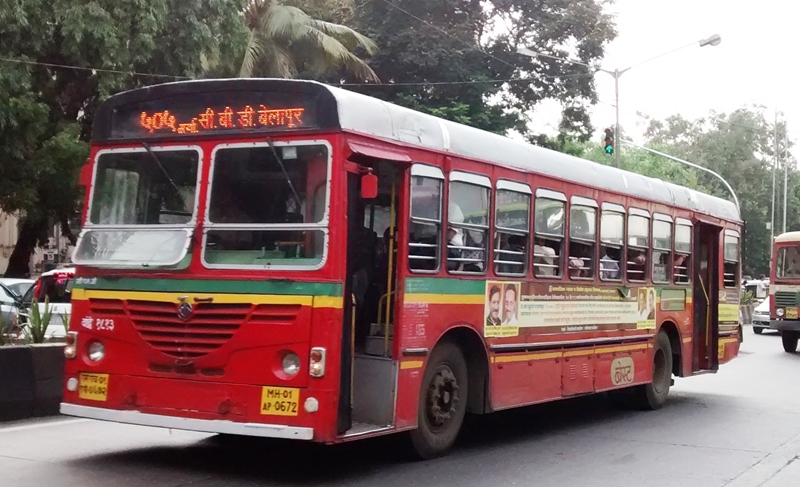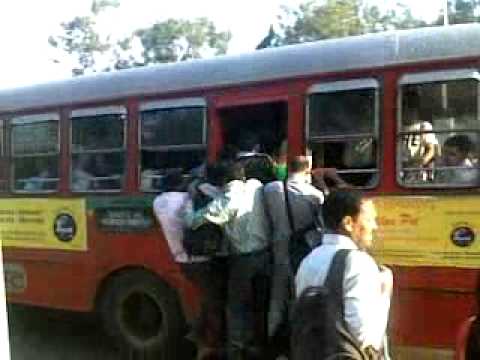
I saw an interesting French comedy film Boss’s Daughter recently. It was also remarkable because of the intelligent use of the concept of ergonomics which involves right use of technology for the human body at the workplace, home or travel.
In his film the boss’s daughter uses the science of ergonomics to see how work in her father’s factory is affecting workers, their bodies, health , which parts of the body are stressed and so on. In the process, she falls in love with a foreman.
Our engineers and managers in bus and train undertakings should see this film because they don’t seem to have a ghost of an idea about ergonomics judging by the bad design in our travel modes.
The BEST Undertaking, once the pride and icon of Mumbai, is now down in the dumps because of incompetent handling at various levels. One of the reasons people are turning away from buses and ridership is falling is the bad design of bus shelters and buses. So sad since the BEST with its red buses has for long been a defining feature of Mumbai along with icons like Marine Drive and Gateway of India.
There is no space to stand or sit properly even for five to six people at a bus stop or shelter, they are so small and narrow and off-putting. Clearly, no one is paying any attention. A bigwig in the undertaking seemed totally unaware of this when I pointed out the terrible state of affairs at a meeting in the city.
Besides, the bus stops and shelters face constant obstruction from cars parked right in front, in the area where buses should stand. This happens right near Mantralaya, the state government headquarters, yet no one takes any measure. The main reason is that people who should act are not even aware of this.
BEST is now in a serious crisis because its services have reduced, it is difficult to get a bus, one has to wait for a long time and the organization does not have money even to pay staff salaries. Can one imagine a city like London starving its bus system of funds. Every city worth the name has to have some pride and look after its public transport well.
In London though there is a very efficient underground train system, bus ridership is even more because bus travel is more convenient, the network reaches all corners. In Mumbai on the other hand, train ridership is rising and bus ridership is falling because of inadequate bus service..
Unless we pay attention to the crisis, we may witness a turning point in Mumbai’s history in the same away as happened in the case of textile mill land development, warns Rajani X Desai of RUPE India, Research Unit in Political Economy. She is a senior economics scholar and was a leading figure on the editorial staff of the Economic and Political Weekly for several years.She and her colleague Girish Srinivasan have studied the BEST issue and got the involvement of other activists in the sector of public transport and a group has been formed.
After reading about the group’s study and concern for public transport, the BEST committee chairman Anil Kokil met the members last week and wants to take the group soon to meet the municipal commissioner Ajoy Mehta to seek subsidy for the BEST and find a solution to the crisis in the city’s public transport.
At the root of the current crisis is the basic antipathy of the establishment to public transport. The authorities are also playing into the hands of private operators. There is the bankrupt policy of commercially redeveloping the land of BEST bus depots when increasing needs of public transport for a growing city require more land. In fact, BEST should acquire more land, not indulge in the damaging, suicidal policy of disposing existing land.
A classic case of bankruptcy is visible to anyone who cares to visit the Seven Bangalows bus depot at Andheri. The mall, built by a developer, on land given by BEST is closed down. The whole place looks eerie, ghost-ridden.A terrible waste of precious resource of land.
The BEST, is facing a crisis of lack of funds and also management.. The BMC and the BEST management want sweeping changes: closure of many routes, steep hike in bus fares, reduction of BEST staff, and engaging of private contractors to run bus services. This has set them on a collision course with the workers of BEST. However, in the public discussion, vital points are being obscured.
Several important points are outlined in the following statement submitted by the study group to BEST.
. There is no new wage demand from the BEST employees. They are simply asking for their existing wages to be paid on time and for the BEST to receive support from the BMC. The funding crisis cannot be ascribed to workers’ wages. Nor is the BEST over-staffed. In fact, according to the BEST’s own calculations, it is short of 605 drivers and 694 conductors to run existing operations.
. The authorities are diverting attention from the fact that the BMC’s ‘reform package’ stipulates reduced services and higher fares for the general public, and creeping privatisation of an essential public service. This ‘reform package’ of the BMC and the BEST management is not in the city’s interest.
. The ‘reform package’ is based on the mistaken idea that BEST must earn a profit at all costs. However, public transport is an essential service which is subsidised the world over, and throughout India. In the case of Mumbai, a large percentage of the population is poor, has limited capacity to pay for transport, and will face even further economic exclusion if fares are raised further.
. The subsidy for BEST services is not new. Before the Electricity Act, 2003, came into existence it was paid for from the surplus from the electricity division. Since then it has become the direct responsibility of the BMC, which BMC has avoided till now. The fact is, the funds crisis of the BEST has been created by the BMC’s attempt to cut off the long-standing subsidy.
. BEST deserves a subsidy, since it substitutes a large number of private vehicles, thereby checking pollution, and reducing road congestion and travel times. Thus it is essential to all citizens’ well-being and to the economic vitality of the city. However, the congestion created by the massive increase in private vehicles has led to the slowing down of BEST buses, fall in BEST revenues, and migration of bus commuters to other forms of transport. This is not the fault of the BEST, but of the city authorities and planners.
. We should assess public transport not by its profits, but by whether it provides convenient, frequent services to the general public, and whether it attracts a large share of total passengers thereby. The number of passengers carried by BEST has fallen by one-third in the last eight years. It is this emergency that the city authorities should be concerned about. Fare hikes will simply drive more commuters out of buses and into private modes of transport, which is harmful for the city. The poorest will simply have to walk longer distances, or lose employment.
. The BMC and BEST management proposal to engage private contractors to supply and run buses will not save money, since the winning bid itself is comparable to or higher than BEST’s costs for the same operations! Moreover, there are risks to safety in the use of low-paid contract drivers in place of the experienced permanent staff, as was seen in operation of Blue line buses in Delhi. The parking and maintenance of buses run by private contractors may have further ill-effects on services, road congestion and safety.
. The BEST has been reducing its fleet size and manpower. Along with congestion, this has contributed to waiting times for commuters rising, and consequent migration of commuters to other modes of transport.
This situation can be remedied. The BMC’s ‘reform package’ must be set aside. Instead:
The BMC, the country’s richest municipality, must accept responsibility for funding the BEST’s current and capital expenditures. It must reverse the shrinking of services of the last decade and instead expand the number of buses, and thereby their frequency. A fraction of the operations subsidy that will go to the Metro rail should suffice to make BEST operations viable.
The Government should provide concessions to lighten the unfair tax burden on BEST. At the same time, private automobiles should be appropriately regulated and their users should be charged for the costs they impose on the city. Reasonable parking fees alone could net more than Rs 400 crore per year, to be set aside exclusively for promoting public and non-motorised transport. This is an appropriate form of cross-subsidy, in line with progressive cities elsewhere in the world. Instead, through various policies, the central, state and local governments have been subsidising the use of private motor vehicles.
The combination of reduced taxes on the BEST, conversion of BMC loans into transfers, and cross-subsidies from parking fees could close much of the funding gap for BEST.
. The traffic police are reportedly contemplating restrictions on the entry and parking of inter-city private buses and heavy vehicles. But the biggest users of road space, totally free, are private cars. Hence we need to focus on right of way for buses on key arteries. The Municipal Corporation should adopt a comprehensive parking policy to prevent private cars from grabbing public space for free, and thereby creating congestion.
Immediately, exclusive bus lanes (wherever feasible) can speed up bus transport. The inconvenience to a minority of highly vocal car users should not outweigh the benefit that will be obtained by very large numbers of poor and middle class citizens.
In the medium term, a well-designed Bus Rapid Transit System is essential in order to draw commuters away from bursting local trains. Even some car users may switch to BRTS to travel at three or four times the current peak period traffic speeds. BRTS can be designed to carry 25 per cent more than the Metro, at one-twentieth to one-thirtieth the price of the Metro.
. Far from being hiked, BEST fares must be reduced substantially in order to draw back passengers who have migrated to private modes of transport. The BMC must provide subsidy per passenger trip and incentivize higher trips per day, in order to partially redress the enormous largesse given to users of private motor vehicles.
. Improvements in passenger comfort, better route management, equipping buses with GPS, and creating apps for bus information can all help – provided adequate services are available and fares are reduced.
The BMC and BEST management should step back from the collision course they are on with their employees. Instead they must work with their employees and their organisations to revive BEST to its premier status of old.
Vidyadhar Date is a senior journalist and author of the book Traffic in the era of climate change. Walking, Cycling, Public Transport need priority.












































